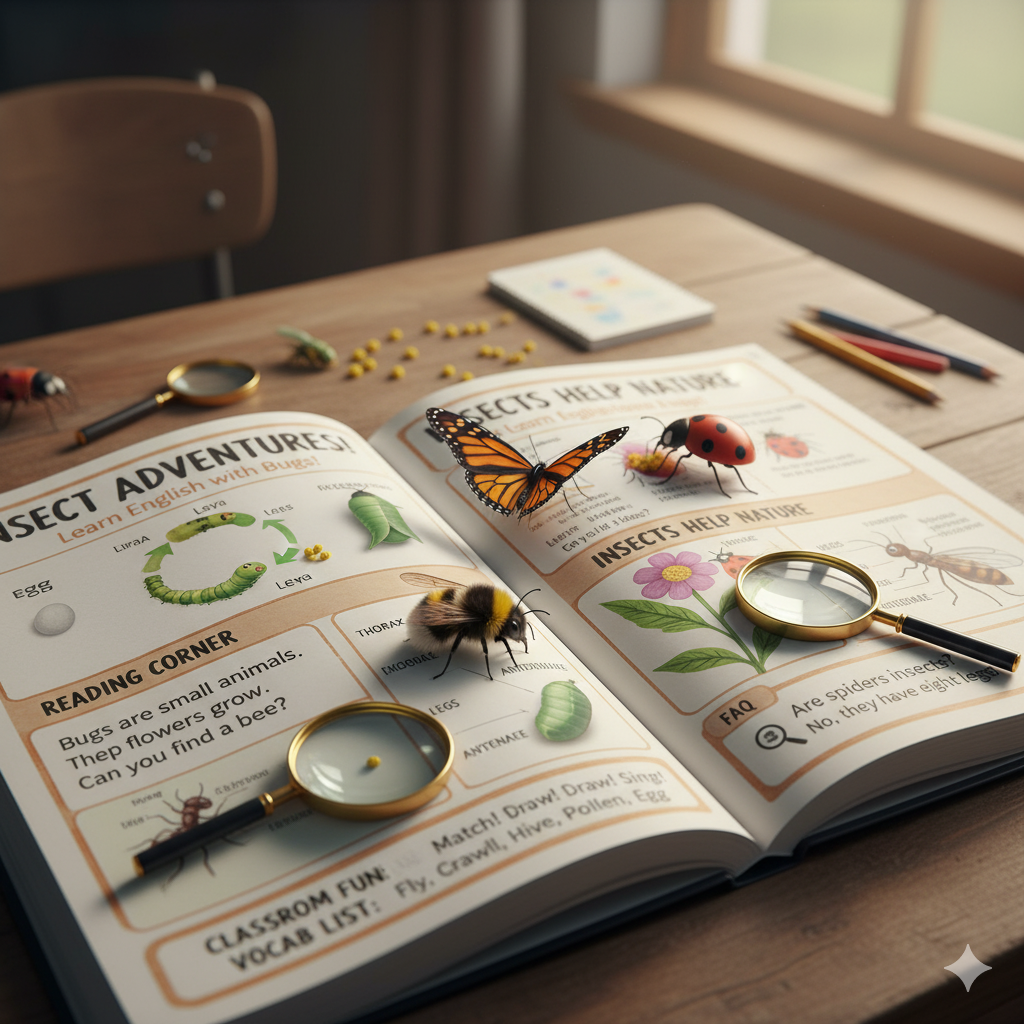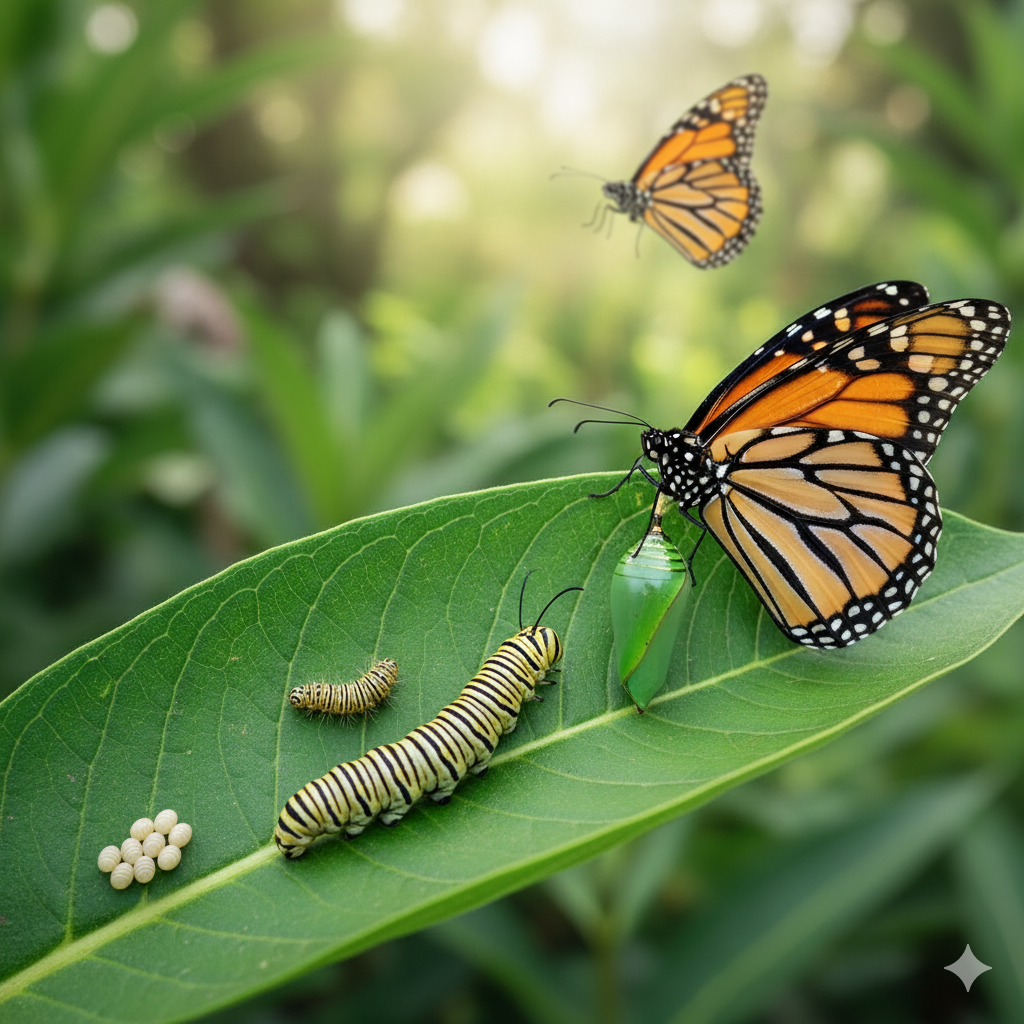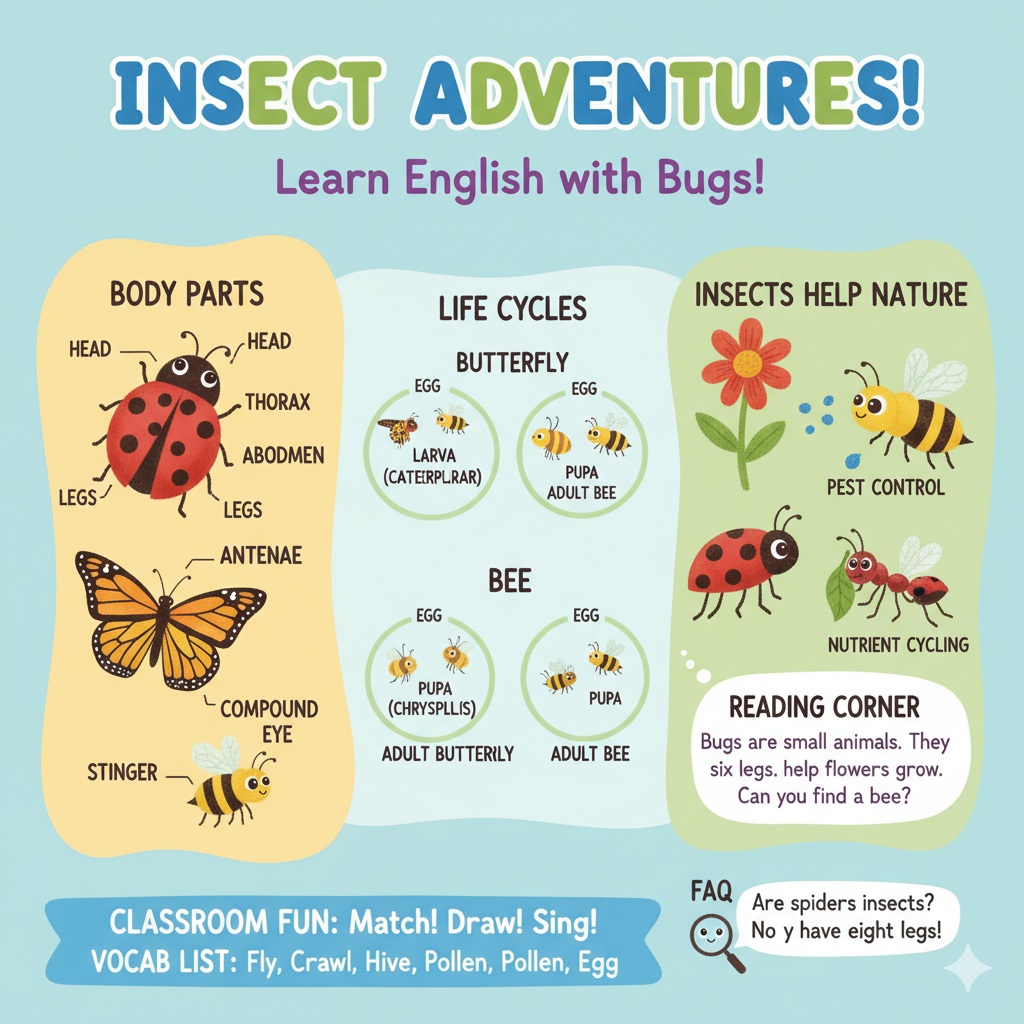Introduction
Learning about the types of insects is a fun way to grow English vocabulary for A1–A2 kids and teens. This guide uses simple language, pictures ideas, and mini-activities to teach body parts, life cycles, and how insects help nature. Includes a short reading, classroom tasks, FAQ, and a ready-to-use vocabulary list.

1. What Is an Insect? (A1)
An insect is a very small animal with a hard outside body. In everyday English, remember: insects are tiny animals you often see in gardens, parks, near water, and sometimes at home. Common types of insects include butterflies, bees, ants, flies, beetles, grasshoppers, and dragonflies.
Simple sentences (A1):
- A butterfly is an insect.
- An ant is a small insect.
- Many types of insects live in my garden.
Try it: Show a picture of two insects and say one sentence about each.
2. Insect Body Parts (A1)
Most insects have:
- Head (with eyes and antennae)
- Thorax (middle part where the legs and wings are attached)
- Abdomen (back part)
Quick facts:
- Insects have six legs (3 pairs).
- Many have one or two pairs of wings (not all insects fly).
- Antennae help them smell, feel, and sense.
- An exoskeleton is a hard shell on the outside.
A1 practice sentence: “A bee has six legs and two wings.”
Pronunciation tip for young learners:
Break longer words into parts: ex-o-skel-e-ton, an-ten-nae, a-bdO-men (stress on “do” in “abdomen”).
3. Main Types of Insects (A1–A2)
Learning types of insects helps you talk about nature in English. Here are easy profiles your students can remember.
-------- Continua após a publicidade --------
3.1 Butterflies and Moths
- Look: Colorful (butterflies) or fuzzy wings (many moths).
- Food: Drink nectar from flowers.
- Fun fact: They change from caterpillar to adult by metamorphosis.
- A1 sentence: “The butterfly has big, colorful wings.”
- Classroom cue: Students draw a caterpillar → chrysalis → butterfly.
3.2 Beetles
- Look: Hard wing covers (like armor).
- Examples: Ladybugs (friendly beetles), scarab beetles.
- A1 sentence: “A ladybug is a red beetle with black spots.”
- Note: Many beetles help recycle plants and wood.
3.3 Bees, Wasps, and Ants (Hymenoptera)
- Look: Often a thin “waist”; many live in groups (colonies).
- Role: Bees pollinate flowers and make honey. Ants work in teams. Wasps can sting.
- A2 idea: “Many types of insects help plants; bees are important pollinators.”
- Safety note: Observe, don’t touch.
3.4 Flies and Mosquitoes (Diptera)
- Look: One pair of wings.
- Note: Flies help clean nature but can carry germs. Mosquitoes bite and can cause problems.
- A1 sentence: “A fly has one pair of wings.”
- Tip: Keep water containers covered to reduce mosquitoes.
3.5 Grasshoppers and Crickets (Orthoptera)
- Look: Strong back legs for jumping.
- Sound: Crickets make music by rubbing their wings.
- A1 sentence: “A grasshopper jumps very high.”
- Fun task: Jump-count game (how many jumps in 10 seconds?).
3.6 Dragonflies and Damselflies (Odonata)
- Look: Long bodies, two pairs of wings, big eyes.
- Habit: Fly fast near water and eat small insects (like mosquitoes).
- A2 sentence: “Dragonflies are quick hunters.”
- Observation idea: Watch them safely near ponds or fountains.
3.7 True Bugs: Cicadas, Aphids, Stink Bugs (Hemiptera)
- Look: Special mouth for sucking juices.
- Note: Some are plant pests; cicadas sing loudly in warm weather.
- A2 sentence: “Some true bugs drink plant sap.”
4. Insect Life Cycle (A1–A2)

Many types of insects follow four stages:
- Egg
- Larva (caterpillar/grub)
- Pupa (chrysalis)
- Adult (butterfly, beetle, etc.)
A1 summary: “First egg, then larva, then pupa, then adult.”
A2 example (butterfly): “The caterpillar eats leaves, then becomes a chrysalis, and finally a butterfly.”
Mini activity: Cut-and-order cards with the four stages; students arrange and read aloud.
5. Where Insects Live (A1)
Insects live almost everywhere:
- Gardens and parks (flowers, grass, trees)
- Near water (ponds, lakes, rivers)
- Forests and fields
- In houses (flies, ants, sometimes moths)
A1 sentence: “Many types of insects live near flowers.”
Task: Class map—write two insects you can find in each place.
6. Helpful vs. Harmful Insects (A2)
Helpful insects
- Bees and butterflies: pollinate flowers → more fruits and seeds.
- Ladybugs: eat plant pests like aphids.
- Dragonflies: reduce mosquitoes.
Harmful insects
- Mosquitoes: bite; in some places, they can carry diseases.
- Aphids and some caterpillars: damage plants.
- Termites: can harm wood.
A2 sentences:
- “Ladybugs are helpful because they eat pests.”
- “Mosquitoes are harmful because they bite.”
Sorting activity: Put picture cards into “Helpful” or “Harmful” and say one reason.
For a kid-friendly deep dive into Types of Insects with clear pictures and explanations, check out the Britannica Kids overview on insects: Insects — Britannica Kids. It’s a reliable reference to reinforce classroom learning with short facts, visuals, and simple definitions.

7. Classroom Mini-Activities (A1–A2)
A. Point and Say (A1)
Show pictures of types of insects. Students point and say: “This is a bee. It has six legs.”
B. Guess the Insect (A2)
Student A gives clues: “It has colorful wings. It drinks nectar.” Student B: “Butterfly!”
C. Life Cycle Line (A1–A2)
Arrange cards: egg → larva → pupa → adult. Learners act each stage.
D. My Garden Poster (A2 writing)
Write 3–5 sentences about insects in a garden. Use the focus keyword once: “There are many types of insects in a garden…”
E. Sentence Starters (A1)
- “This insect is a ___.”
- “It has ___ legs and ___ wings.”
- “It is helpful/harmful because ___.”
8. Key Vocabulary (A1–A2)
Body & Biology: insect, antennae, wings, legs, head, thorax, abdomen, exoskeleton, larva, pupa, adult, life cycle, metamorphosis, nectar, sap, pollinate
Insects: butterfly, moth, caterpillar, chrysalis, beetle, ladybug, bee, wasp, ant, hive, honey, fly, mosquito, grasshopper, cricket, dragonfly, damselfly, cicada, aphid, stink bug
Use in sentences:
- “This insect is a butterfly. It drinks nectar.”
- “A ladybug is helpful. It eats aphids.”
- “Some types of insects are harmful to plants.”
Quer outra lição A1–A2 com vocabulário e atividades prontas? Explore nosso guia de Days of the Week com pronúncia, curiosidades e 2 jogos imprimíveis: Days of the Week – 2 Games & Activities. É um ótimo complemento para revisar palavras e treinar frases simples.
9. Short Reading Practice (A1–A2)
The Garden Walk
Today our class visits a small garden. We look for many types of insects. First, we see a butterfly. It drinks nectar from pink flowers. Next, a bee flies to a yellow flower. Bees are helpful because they pollinate plants. We also see a ladybug on a leaf. It eats aphids, so the plant stays healthy. Near the pond, a dragonfly moves very fast. It catches mosquitoes in the air. Finally, we find a grasshopper in the grass. It can jump very high! We write notes and draw pictures. In the garden, we can find many types of insects and learn new English words.
Comprehension checks:
- Which insects drink nectar? (Butterflies, bees)
- Which insect eats aphids? (Ladybug)
- Where do we see a dragonfly? (Near the pond)
- What can a grasshopper do? (Jump very high)
- Why are bees helpful? (They pollinate plants)
10. Speaking & Writing Frames (A1–A2)
- “My favorite insect is a __ because __.”
- “In my park, I see __ and __.”
- “This insect is helpful/harmful because __.”
- “Its life cycle is: egg → __ → __ → adult.”
A2 paragraph model (fill-in):
“In my neighborhood, there are many types of insects. I often see __ near flowers. I also see __ in the grass. __ are helpful because __. We should protect insects and learn their names in English.”
Short Reading Practice 2 (A1–A2)
The Schoolyard Survey
On Friday morning, our class does a small survey about nature. We walk around the schoolyard with notebooks. We want to find different types of insects. First, we see a bee on a yellow flower. It moves slowly and collects pollen. Next, near the wall, we find a line of ants. They work together and carry tiny pieces of bread. By the sports court, a red ladybug sits on a green leaf.
Our teacher says ladybugs help plants because they eat aphids. Close to a puddle after the rain, a fast dragonfly flies in circles. It catches small insects in the air. We do not touch any insects; we only watch and draw. Back in class, we make a poster. We write: “The schoolyard has many types of insects that help the garden.”
Comprehension Questions
- Where does the survey happen?
a) In the forest b) In the schoolyard c) At home - What does the bee collect?
a) Water b) Pollen c) Wood - What do the ants carry?
a) Leaves b) Stones c) Tiny pieces of bread - Why are ladybugs helpful?
a) They make honey b) They eat aphids c) They sing at night - Where do students see the dragonfly?
a) In the classroom b) By the sports court, near a puddle c) On a tree - True or False: The students touch the insects to learn about them.
- Short answer: Name two types of insects seen in the survey.
- Short answer: What do students make when they return to class?
11. Conclusion (A1–A2)
Learning about types of insects is a fun way to build real-world English at A1–A2. In this lesson, students practiced body parts (head, thorax, abdomen), learned simple life-cycle steps (egg → larva → pupa → adult), and saw how insects can be helpful (bees, ladybugs, dragonflies) or harmful (mosquitoes, aphids). With short readings, picture-based tasks, and sentence frames, young learners can name common insects and describe what they do using clear, simple English.
To extend learning, take a short “insect walk” at school or at home (with adult supervision). Ask learners to spot two or three insects, then write one sentence about each: “This insect is a . It has legs and __ wings.” Small observations like these make vocabulary stick and turn the types of insects into memorable, everyday English.
FAQ: Types of Insects
1) What are the most common types of insects for A1 learners?
Butterflies, bees, ants, flies, beetles, grasshoppers, and dragonflies.
2) How many legs do insects have?
Most insects have six legs.
3) Do all insects fly?
No. Many can fly, but not all insects have wings, and some rarely fly.
4) Are all insects harmful?
No. Many types of insects are helpful—bees pollinate, ladybugs eat pests, dragonflies reduce mosquitoes.
5) What is metamorphosis?
It is the change from egg → larva → pupa → adult, like a caterpillar becoming a butterfly.
6) Where can children safely observe insects?
In gardens, parks, and school yards—always with an adult and without touching or harming insects.
Answer Key (Teacher Support)
1) Section 2 – Body Parts (A1)
- Main parts: Head – Thorax – Abdomen
- Legs: 6 (three pairs)
- Wings: 1–2 pairs (some insects don’t fly)
- Other: Antennae; exoskeleton (hard outer shell)
- Model sentence: “A bee has six legs and two wings.”
2) Section 4 – Life Cycle (A1–A2)
- General order: Egg → Larva → Pupa → Adult
- Butterfly: Egg → Caterpillar (larva) → Chrysalis (pupa) → Adult butterfly
- Bee: Egg → Larva → Pupa → Adult bee
3) Section 6 – Helpful vs. Harmful (A2)
- Helpful (sample correct): Bees, Butterflies, Ladybugs, Dragonflies
- Harmful (sample correct): Mosquitoes, Aphids, Termites, (some) Caterpillars
- Note: Cicadas are generally neutral to harmless; answers may vary by local context.
4) Section 7 – Classroom Mini-Activities (A1–A2)
A. Point and Say: Any correct identification with a simple sentence is acceptable (e.g., “This is a bee. It has six legs.”)
B. Guess the Insect: Accept reasonable matches from clues (e.g., “colorful wings, nectar” → butterfly).
C. Life Cycle Line: Egg → Larva → Pupa → Adult.
D. My Garden Poster: Accept 3–5 grammatically simple sentences; look for accurate vocab and one use of the keyword if requested.
E. Sentence Starters: Answers vary; check for target structure and insect vocabulary accuracy.
5) Section 8 – Key Vocabulary (Spot-check)
- Pollinate: Help plants make seeds/fruit (bees, butterflies).
- Nectar: Sweet liquid in flowers, food for many insects.
- Sap: Plant juice; some true bugs (e.g., aphids) drink it.
- Metamorphosis: Major change across stages (egg → larva → pupa → adult).
6) Section 9 – Short Reading Practice: “The Garden Walk”
- Which insects drink nectar? Butterflies and bees.
- Which insect eats aphids? Ladybug.
- Where do we see a dragonfly? Near the pond.
- What can a grasshopper do? Jump very high.
- Why are bees helpful? They pollinate plants.
Answer Key – Short Reading Practice 2
- b) In the schoolyard.
- b) Pollen.
- c) Tiny pieces of bread.
- b) They eat aphids.
- b) By the sports court, near a puddle.
- False. They only watch and draw.
- Any two of: bee, ants, ladybug, dragonfly.
- A poster (about the insects in the schoolyard).
7) Optional Quick Quiz (use if needed)
- How many legs do insects have? 6.
- Order the stages: Egg → Larva → Pupa → Adult.
- Helpful or harmful? Ladybug = helpful; Mosquito = harmful; Dragonfly = helpful; Aphid = harmful.
- Name two insect body parts: Head, thorax, abdomen, antennae, wings, legs (any two).



